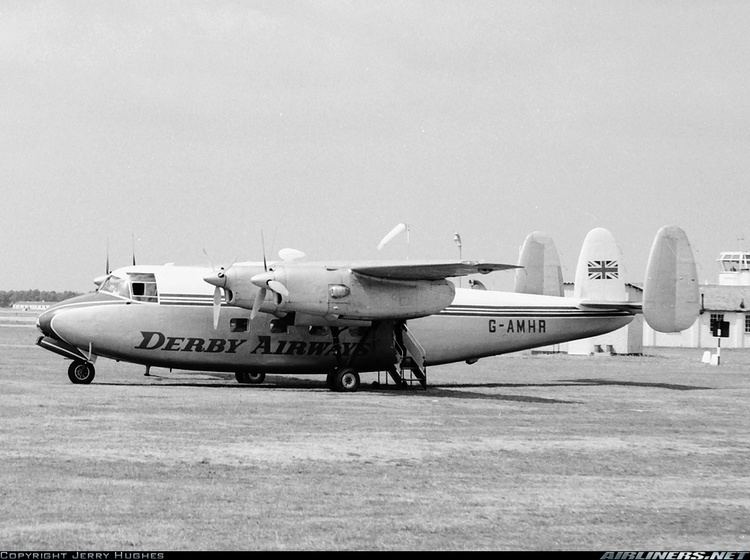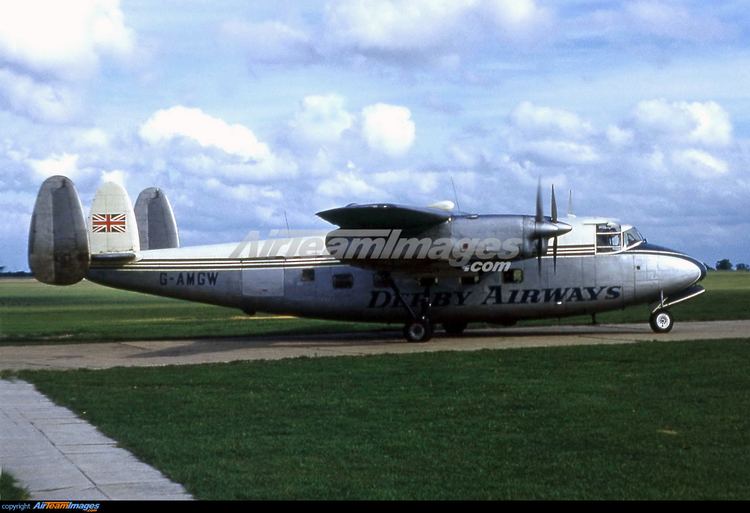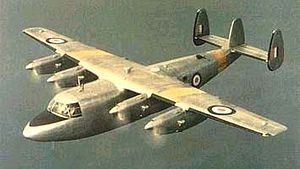Length 16 m Wingspan 20 m | Top speed 322 km/h First flight May 19, 1946 | |
 | ||
The Handley Page (Reading) H.P.R.1 Marathon was a British civil 20-passenger light transport produced by Handley Page (Reading) Limited of Woodley Aerodrome, Reading, England.
Contents
- Design and development
- Operational history
- Variants
- Civil operators
- Military and government operators
- Accidents and incidents
- Specifications Marathon 1
- References

Design and development

The Marathon originated as a design to meet the requirements of the Brabazon Committee. It was designed by Miles Aircraft Limited as a high-wing cantilever monoplane with four engines and all-metal construction. It was capable of carrying two crew and up to 20 passengers. The aircraft was designated the Miles M.60 Marathon with the first of three prototypes (registered U-10) flying on 19 May 1946. A total of 25 aircraft were ordered by the Ministry of Supply and 25 by British European Airways, but Miles had financial problems and needed orders for over 100, not helped when the prototype aircraft crashed and the power shortages led to the loss of components already produced. When the Miles company went bankrupt, Handley Page bought the assets, including the factory at Woodley near Reading, Berkshire and design rights to the Marathon.

The new company, known as Handley Page (Reading) Limited, started producing the Marathon with 40 aircraft built over the next three years with the new designation Handley Page (Reading) H.P.R.1 Marathon 1. A twin-engine prototype turboprop-powered version (using the Armstrong Siddeley Mamba) was flown in 1949.
Operational history

The first production Marathon 1 aircraft (registered G-ALUB) left Woodley on 14 January 1950 for a sales tour of Australia and New Zealand. The aircraft was painted in BEA markings as "Rob Roy" in September 1951 and was demonstrated to the airline at Heathrow. During acceptance tests for British European Airways it was decided that the Marathon was not suitable to replace the de Havilland Dragon Rapide and the order was reduced to seven aircraft, none of which were accepted by BEA.
Six Marathons were delivered to the West African Airways Corporation in late 1952 for operation in and between the British colonies in that region. They were replaced in 1954 by de Havilland Herons. The last three production aircraft were given increased tankage and sold to Union of Burma Airways which operated them in the region for several years.
Most of the returned and unsold aircraft were then diverted for use by the Royal Air Force as navigation trainers with the designation Marathon T.11. After internal modifications, most of the 28 aircraft taken on charge from early 1953 were used by No. 2 Air Navigation School at RAF Thorney Island, Hants. A total of 16 aircraft were transferred to RAF Topcliffe, Yorks in June 1958 when No.1 Air Navigation School relocated there. By February 1969, only eight were airworthy. Apart from mechanical unreliability, the main problem was tail-heavy trim, an absolute ceiling of 9,500 feet, and a rate of climb of only 300 ft a minute. The navigational trainers were retired in April 1959 and most were quickly scrapped. A few Marathons were operated by other UK military users including the Royal Aircraft Establishment.
Three Marathons were acquired in 1955 by Derby Aviation, based at Burnaston airport near Derby and predecessor of British Midland Airways. The aircraft were used on scheduled services within the UK and to the Channel Islands until their withdrawal in December 1960. Two aircraft (G-ALVY/XA252 and G-AMER/XA261) were returned from the RAF to F.G. Miles at Shoreham for planned use on scheduled services but this failed to happen and they were scrapped in 1962. One aircraft was delivered to Jordan in September 1954 for the personal use of King Hussein.
The Mamba-powered Marathon testbed was later fitted with Alvis Leonides Major radial engines and used as a testbed for the projected Herald.
No surviving airframes are known to exist but the upper fuselage section of Marathon M.60 G-AMGW was stored at Woodley, United Kingdom as part of the Miles Collection c. 2000
Variants
Civil operators
Military and government operators
Accidents and incidents
Specifications (Marathon 1)
Data from British Civil Aircraft since 1919: Volume 2.
General characteristics
Performance
